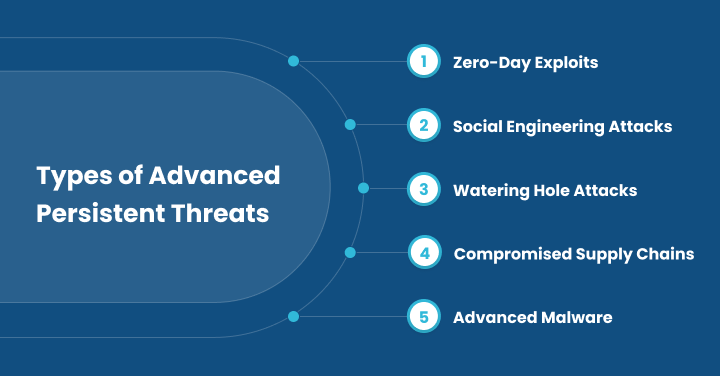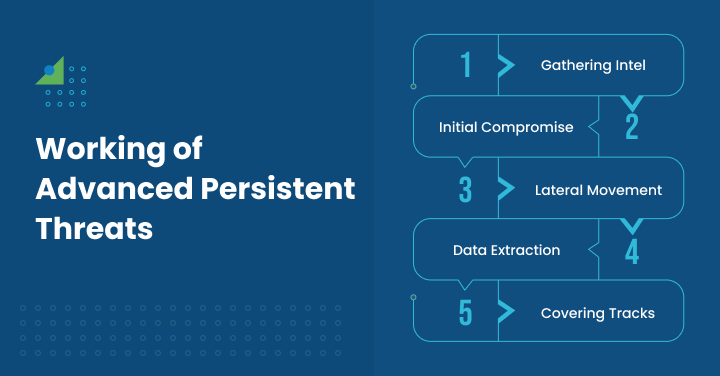Advanced Persistent Threats (APTs) lurk in the shadows of the digital world, enabling malicious parties to operate undetected within your network for months or even years.
These threats often target specific organizations or entities to steal sensitive information or sabotage critical infrastructure. Learn about the types, how they work, and crucial steps to prevent them.
Types of Advanced Persistent Threats

The types of advanced persistent threats typically comprise the following:
1. Zero-Day Exploits
Zero-day APTs target previously unknown vulnerabilities in computer networks, referred to as such since developers have to handle them with no warning signs. Exploiting these vulnerabilities allows APTs to gain unauthorized access, install malware, or steal sensitive data.
For example, the Stuxnet attack targeted four zero-day vulnerabilities in Microsoft Windows systems and caused considerable damage to Iran’s nuclear program.
2. Social Engineering Attacks
Social engineering techniques, such as phishing or pretexting, are commonly used to imitate trusted entities and deceive users into offering sensitive information, clicking on malicious links, or downloading malware-infected files. For instance, a phishing email scam once stole $100 million from Google and Facebook.
3. Watering Hole Attacks
Watering hole attacks inject malicious code into websites frequently used by the target organization’s employees or customers to infect systems with malware and establish a presence within the network. The United States Department of Labor website was infected with malware a few years ago, which aimed to gather information from visitors.
4. Compromised Supply Chains
APTs can target partners of the target organization to gain access to its network indirectly. Malware is injected into legitimate software updates or hardware components to access the network undetected. In 2020, a supply chain breach was utilized to obtain the information of thousands of SolarWinds users.
5. Advanced Malware
APTs deploy advanced malware designed to evade detection and maintain presence within the network. This malware may include remote access trojans or polymorphic malware that can change its code to avoid detection mechanisms. Zeus, a trojan created to infect files distributed through emails and websites, inflicted damages of more than $100 million on companies such as Amazon and Bank of America.
The Working of Advanced Persistent Threats
The typical lifecycle of an APT attack consists of the following stages:
1. Gathering Intel
APT parties gather information about the target organization, infrastructure, employees, and security measures by scanning for vulnerabilities and identifying potential entry points.
2. Initial Compromise
APTs employ various approaches, such as spear-phishing emails, watering hole attacks, or exploiting unpatched software vulnerabilities, to gain initial entry into the target network. Once inside, they deploy backdoors or malware to establish persistence and maintain access.
3. Lateral Movement
With an undetectable presence established, APTs move laterally across the network to escalate privileges, bypass security controls, and access valuable data. They exploit weaknesses in network segmentation or misconfigured systems to facilitate discreet navigation.
4. Data Extraction
The primary objective of APT attacks is to steal sensitive data without raising the alarm. Various techniques, such as encryption or covert channels, extract sensitive data while remaining undetected by the network’s security protocols.
5. Covering Tracks
To evade detection, APTs cover their tracks by deleting logs, changing timestamps, or deploying anti-forensic tools, allowing them to erase any traces of their presence in the target environment.
Preventing Advanced Persistent Threats
Here are some key strategies to prevent APT attacks:
1. Risk Assessment
Conduct regular assessments to identify potential vulnerabilities and prioritize security measures. Stay informed about emerging threats through threat intelligence feeds and industry reports. For banks and financial institutions, ransomware and phishing are highly exploitable threats. Assessing cybersecurity risks helps institutions bolster security measures and mitigate damages.
2. Secure Network Architecture
Implement network segmentation, privilege access controls, and authentication mechanisms to limit the impact of lateral movement by APTs. Deploy intrusion detection and prevention systems, next-generation firewalls, and network traffic analysis tools to detect and block suspicious activities. Such security measures enable banking and financial services to safeguard sensitive customer information and deny unauthorized access.
3. Endpoint Security
Deploy advanced endpoint protection solutions, such as endpoint detection and response platforms, antivirus software, and firewalls, to detect and block malicious activities on endpoints. By implementing proactive safety measures, financial corporations can continuously monitor their networks and maintain adherence to safety protocols.
4. Incident Response and Containment
Develop and regularly test an incident response plan to respond to APT incidents. Establish procedures for detecting, containing, and handling APT threats, including isolating compromised systems and performing operation backups. Institutions such as banks and insurance agencies should have extensive response plans in place to protect sensitive data and reduce the risk of unauthorized access.
5. Continuous Monitoring
Implement continuous monitoring solutions to detect suspicious activities and behaviors associated with APTs. Conduct proactive threat detection exercises to search for signs of APT activity that may evade automated detection mechanisms. Financial organizations should utilize continuous monitoring solutions to protect the integrity of their customer information databases.

